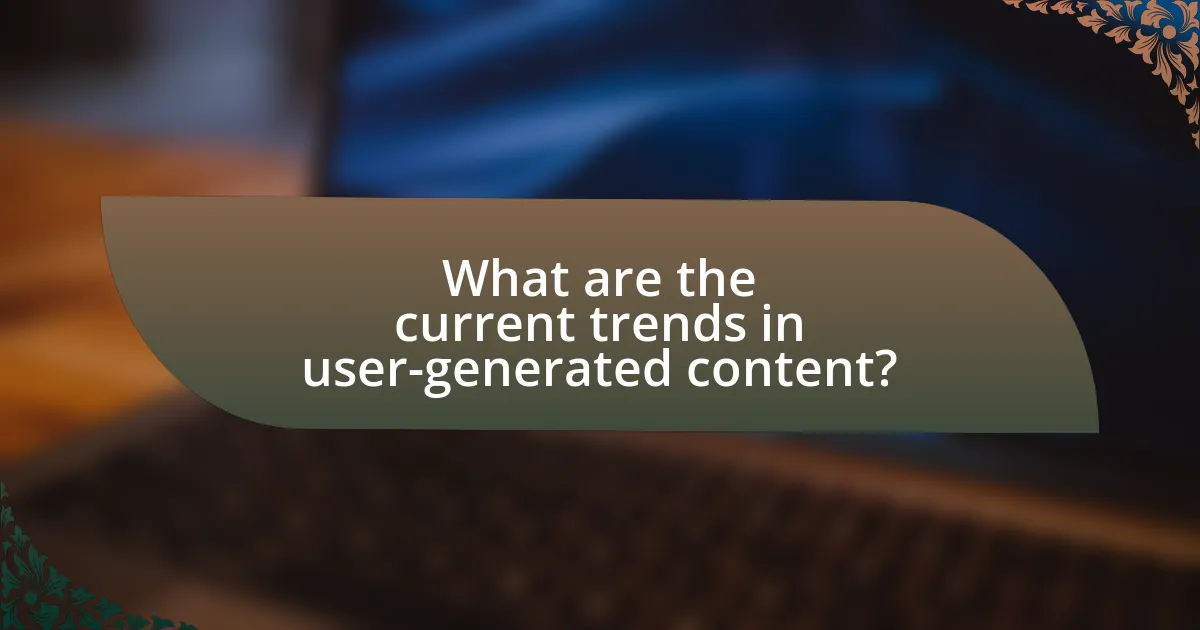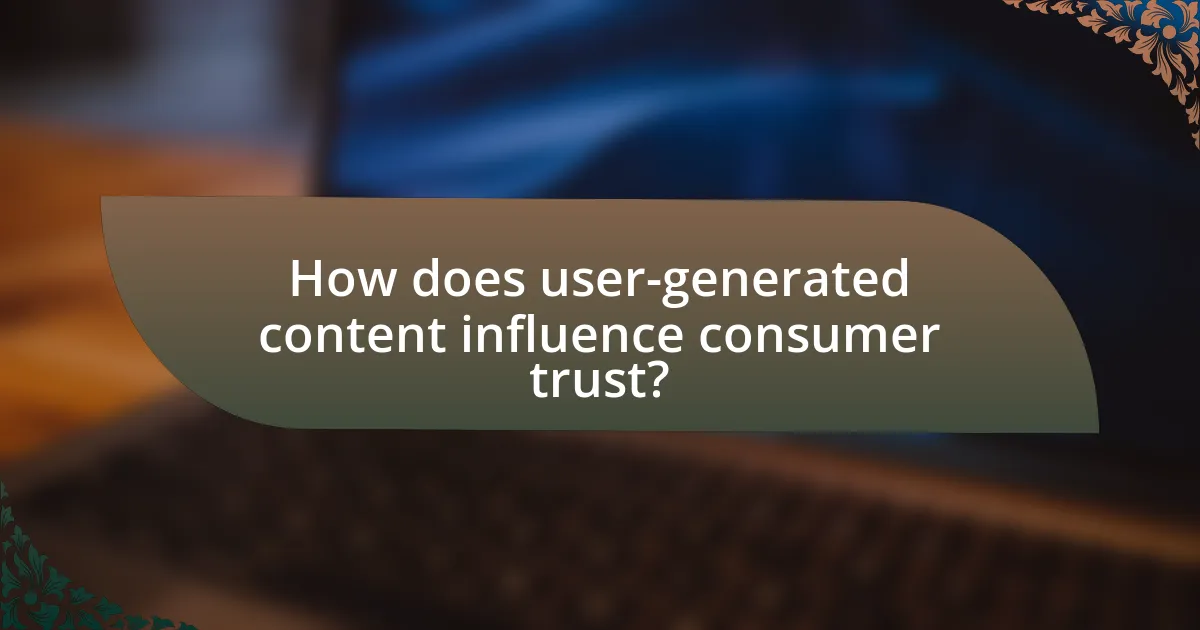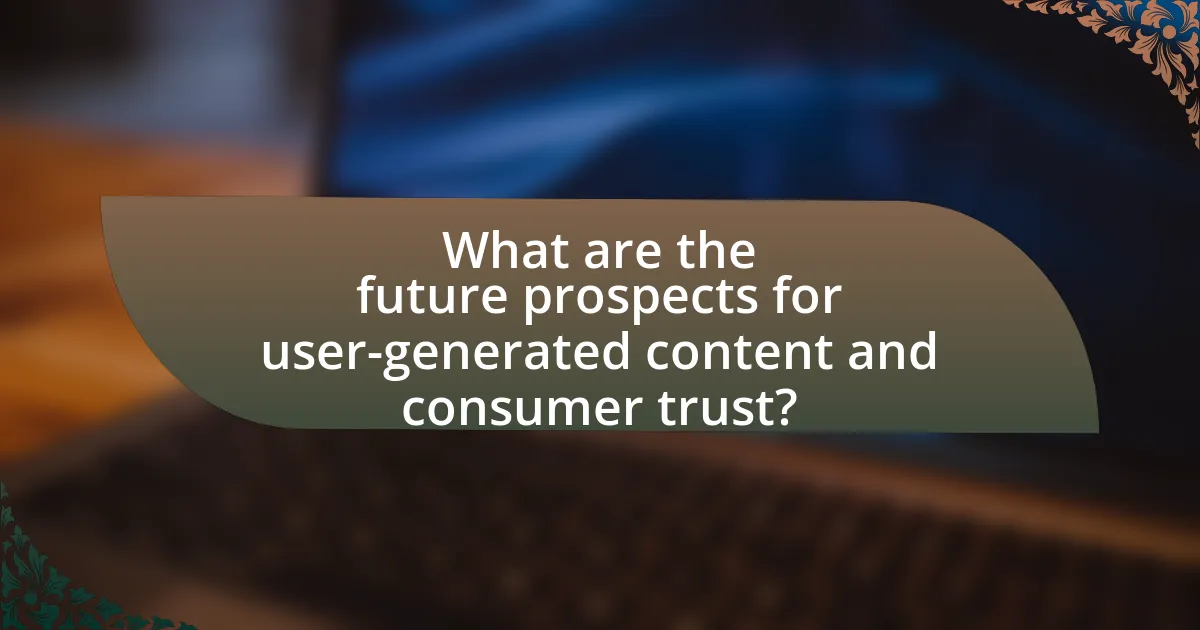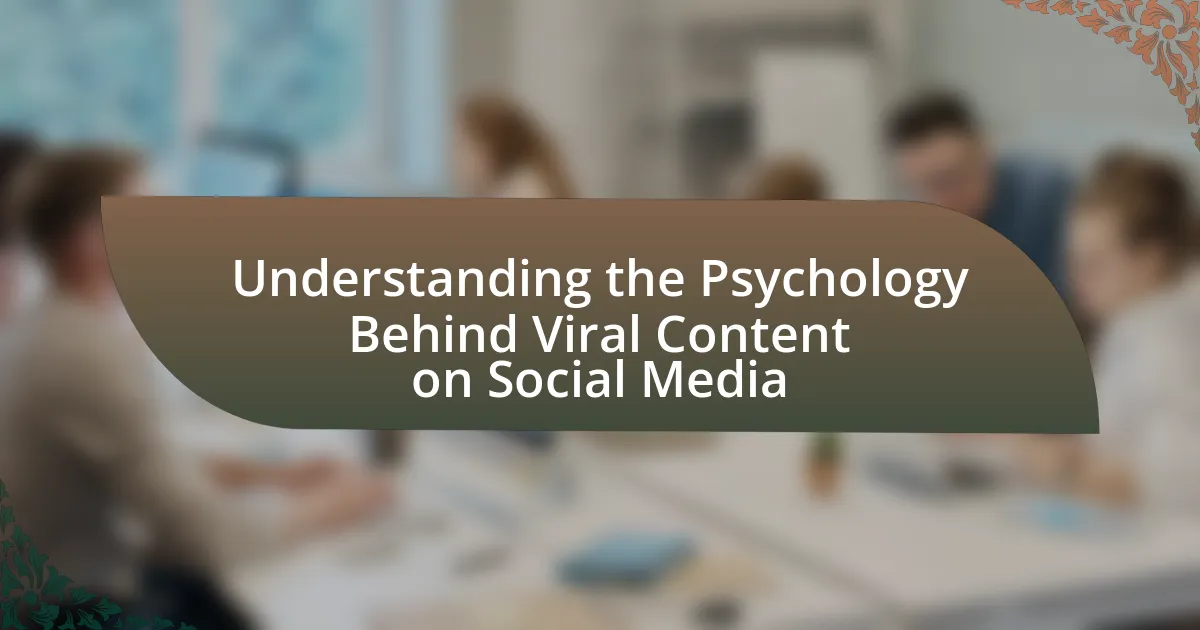The article focuses on trends in user-generated content (UGC) and its significant influence on consumer trust. Key trends include the rise of short-form video platforms, the demand for authenticity in content, and the integration of augmented reality features. It highlights how social media has democratized content creation, with platforms like YouTube, Instagram, TikTok, and Reddit leading in UGC engagement. The article also examines the impact of demographics on content preferences, the types of UGC that are most effective, and the psychological factors that enhance consumer trust. Additionally, it discusses the importance of UGC for brands, the challenges they face in managing it, and the future prospects shaped by emerging technologies.

What are the current trends in user-generated content?
Current trends in user-generated content include the rise of short-form video platforms, increased authenticity in content creation, and the integration of augmented reality features. Short-form videos, particularly on platforms like TikTok and Instagram Reels, have gained immense popularity, with users creating engaging content that often goes viral. Authenticity is increasingly valued, as consumers prefer genuine experiences over polished marketing, leading brands to leverage real customer stories and testimonials. Additionally, augmented reality is being utilized to enhance user engagement, allowing users to interact with products in innovative ways. According to a 2023 report by HubSpot, 79% of consumers say user-generated content highly impacts their purchasing decisions, highlighting its significant influence on consumer trust.
How has the rise of social media influenced user-generated content?
The rise of social media has significantly increased the volume and diversity of user-generated content. Platforms like Facebook, Instagram, and Twitter enable users to easily create, share, and engage with content, leading to a democratization of information where anyone can contribute. According to a 2021 report by Statista, over 4.2 billion people worldwide use social media, which has facilitated the rapid dissemination of user-generated content across various demographics and interests. This surge in content creation has transformed marketing strategies, as brands increasingly rely on authentic user-generated content to build trust and engage consumers, with 79% of people stating user-generated content highly impacts their purchasing decisions, as reported by Nielsen.
What platforms are most popular for user-generated content?
The most popular platforms for user-generated content are YouTube, Instagram, TikTok, and Reddit. YouTube leads with over 2 billion monthly active users, allowing individuals to share videos and engage with a global audience. Instagram, with over 1 billion users, focuses on photo and video sharing, fostering community interaction through comments and likes. TikTok, rapidly growing with over 1 billion users, emphasizes short-form video content, encouraging creativity and virality. Reddit, with around 430 million users, serves as a forum for discussions and content sharing across diverse topics, enabling users to contribute and vote on content. These platforms collectively shape trends in user-generated content and significantly influence consumer trust through authentic engagement.
How do trends in user-generated content vary across different demographics?
Trends in user-generated content (UGC) vary significantly across different demographics, influenced by factors such as age, gender, and cultural background. For instance, younger demographics, particularly Generation Z and Millennials, tend to engage more with platforms like TikTok and Instagram, favoring short-form video content and visual storytelling. In contrast, older demographics, such as Baby Boomers, often prefer platforms like Facebook, where longer text posts and community engagement are more prevalent.
Research indicates that 60% of Gen Z consumers prefer video content, while 70% of Baby Boomers are more likely to engage with written content (Source: “The Future of Content Marketing,” HubSpot, 2022). Additionally, gender differences also play a role; women are more likely to share personal experiences and lifestyle content, while men often focus on technology and gaming-related UGC. This demographic variation in content preferences highlights the need for brands to tailor their UGC strategies to resonate with specific audience segments effectively.
What types of user-generated content are most impactful?
The most impactful types of user-generated content include reviews, testimonials, and social media posts. Reviews significantly influence consumer purchasing decisions, with 79% of consumers trusting online reviews as much as personal recommendations, according to a study by BrightLocal. Testimonials provide authentic experiences that enhance credibility, while social media posts, particularly those featuring user experiences or unboxing videos, create relatable content that fosters trust. These forms of content leverage social proof, which is crucial in shaping consumer perceptions and driving engagement.
How do reviews and testimonials shape consumer perceptions?
Reviews and testimonials significantly shape consumer perceptions by providing social proof and influencing trust. When potential customers read positive reviews, they often perceive the product or service as credible and reliable, which can lead to increased purchase intentions. According to a study by BrightLocal, 79% of consumers trust online reviews as much as personal recommendations, highlighting the impact of user-generated content on consumer decision-making. Furthermore, negative reviews can deter consumers, as 94% of users reported avoiding a business after reading a negative review, demonstrating the powerful role that reviews and testimonials play in shaping overall consumer sentiment and behavior.
What role do images and videos play in user-generated content?
Images and videos are crucial components of user-generated content as they enhance engagement and authenticity. Visual elements significantly increase the likelihood of content being shared, with studies showing that posts containing images receive 94% more views than those without. Additionally, videos can convey emotions and narratives more effectively than text alone, fostering a deeper connection between the creator and the audience. This visual storytelling aspect builds trust, as consumers often perceive user-generated content with images and videos as more relatable and credible compared to traditional marketing.
Why is user-generated content important for brands?
User-generated content is important for brands because it enhances authenticity and builds consumer trust. When potential customers see content created by actual users, it serves as social proof, demonstrating that the brand is credible and valued by real people. According to a study by Nielsen, 92% of consumers trust recommendations from individuals over brands, highlighting the significant impact of user-generated content on purchasing decisions. This type of content also fosters community engagement, encouraging interaction and loyalty among consumers, which can lead to increased brand advocacy and sales.
How does user-generated content enhance brand authenticity?
User-generated content enhances brand authenticity by providing genuine, relatable experiences that resonate with consumers. This type of content, created by actual users rather than the brand itself, fosters trust as it reflects real-life interactions and opinions. According to a study by Nielsen, 92% of consumers trust organic, user-generated content more than traditional advertising, highlighting its impact on perceived authenticity. Furthermore, brands that showcase user-generated content often see increased engagement and loyalty, as consumers feel a stronger connection to brands that reflect their own experiences and values.
What are the potential risks associated with user-generated content?
The potential risks associated with user-generated content include misinformation, brand reputation damage, and legal liabilities. Misinformation can spread rapidly through user-generated platforms, leading to consumers making decisions based on false information, which can harm both individuals and brands. Brand reputation damage occurs when negative or inappropriate content is associated with a brand, potentially resulting in loss of consumer trust and sales. Legal liabilities arise from issues such as copyright infringement or defamation, where user-generated content may violate laws, exposing companies to lawsuits and financial penalties. These risks highlight the need for careful management and moderation of user-generated content to protect both consumers and brands.

How does user-generated content influence consumer trust?
User-generated content significantly enhances consumer trust by providing authentic and relatable experiences from real users. This type of content, such as reviews, testimonials, and social media posts, serves as social proof, demonstrating that others have had positive experiences with a product or service. Research indicates that 79% of consumers trust online reviews as much as personal recommendations, highlighting the impact of user-generated content on purchasing decisions. Furthermore, platforms that showcase user-generated content often see increased engagement and conversion rates, as consumers feel more confident in their choices when they perceive transparency and authenticity in the information presented.
What psychological factors contribute to consumer trust in user-generated content?
Psychological factors that contribute to consumer trust in user-generated content include perceived authenticity, social proof, and relatability. Perceived authenticity arises when consumers believe that the content is genuine and not influenced by commercial interests, which enhances trust. Social proof, such as the number of likes, shares, or comments, signals to consumers that others find the content credible, reinforcing their trust. Relatability occurs when consumers identify with the content creator, leading to a stronger emotional connection and increased trust. Research indicates that 79% of consumers say user-generated content highly impacts their purchasing decisions, highlighting the importance of these psychological factors in fostering trust.
How does perceived authenticity affect consumer trust?
Perceived authenticity significantly enhances consumer trust. When consumers believe that a brand or product is genuine and true to its values, they are more likely to engage with it and make purchases. Research indicates that 86% of consumers consider authenticity important when deciding which brands to support, as highlighted in a study by Stackla, which surveyed over 1,000 consumers. This trust stems from the belief that authentic brands are transparent, reliable, and aligned with consumer values, leading to increased loyalty and positive word-of-mouth.
What role does social proof play in building consumer trust?
Social proof significantly enhances consumer trust by providing validation through the experiences and opinions of others. When potential buyers observe positive feedback, reviews, or endorsements from previous customers, they are more likely to perceive a product or service as credible and reliable. Research indicates that 79% of consumers trust online reviews as much as personal recommendations, highlighting the impact of social proof on purchasing decisions. This phenomenon occurs because individuals often look to the behavior of others to guide their own choices, especially in uncertain situations.
How do brands leverage user-generated content to build trust?
Brands leverage user-generated content (UGC) to build trust by showcasing authentic customer experiences and testimonials. This strategy enhances credibility, as consumers often perceive UGC as more genuine and relatable compared to traditional advertising. According to a study by Nielsen, 92% of consumers trust recommendations from individuals over brands, highlighting the effectiveness of UGC in fostering trust. By integrating UGC into marketing campaigns, brands can create a sense of community and engagement, further solidifying consumer confidence in their products or services.
What strategies can brands use to encourage user-generated content?
Brands can encourage user-generated content (UGC) by implementing strategies such as hosting contests, creating branded hashtags, and engaging with their audience on social media platforms. Contests incentivize participation by offering rewards for the best submissions, which can significantly increase UGC; for example, a study by Tailwind found that brands using contests see a 34% increase in engagement. Branded hashtags help to organize and promote UGC, making it easier for users to contribute and for brands to track submissions. Additionally, actively engaging with users by liking, sharing, and commenting on their posts fosters a sense of community and encourages more content creation. These strategies not only enhance brand visibility but also build consumer trust, as UGC is perceived as more authentic and relatable.
How can brands effectively showcase user-generated content?
Brands can effectively showcase user-generated content by integrating it into their marketing strategies across various platforms. This can be achieved through social media campaigns that encourage customers to share their experiences, utilizing hashtags to create a community around the brand. For instance, a study by Nosto found that 79% of consumers say user-generated content highly impacts their purchasing decisions, demonstrating the effectiveness of this approach. Additionally, brands can feature user-generated content on their websites, in email newsletters, and in advertising, which not only enhances authenticity but also fosters trust among potential customers.
What are the challenges brands face in managing user-generated content?
Brands face several challenges in managing user-generated content, including quality control, brand reputation, and legal issues. Quality control is a significant challenge as brands must sift through vast amounts of content to identify high-quality contributions that align with their messaging. This process can be time-consuming and resource-intensive. Brand reputation is also at risk, as negative or inappropriate user-generated content can harm public perception; for instance, a study by the Content Marketing Institute found that 79% of consumers believe user-generated content highly influences their purchasing decisions. Additionally, legal issues arise from copyright infringement and liability for harmful content, necessitating brands to implement clear guidelines and monitoring systems. These challenges require strategic management to leverage user-generated content effectively while mitigating risks.
How can brands address negative user-generated content?
Brands can address negative user-generated content by actively monitoring their online presence and responding promptly to negative feedback. This approach allows brands to demonstrate their commitment to customer satisfaction and transparency. Research indicates that 70% of consumers are more likely to trust a brand that responds to negative reviews, as it shows accountability and willingness to improve. By engaging with customers, brands can mitigate the impact of negative content and potentially turn dissatisfied customers into advocates.
What measures can brands take to ensure quality in user-generated content?
Brands can ensure quality in user-generated content by implementing clear guidelines and moderation processes. Establishing specific criteria for submissions helps users understand what is expected, while active moderation ensures that content aligns with brand values and quality standards. Research indicates that brands that actively engage in content curation see a 30% increase in consumer trust, as users perceive higher authenticity and relevance in the shared content. Additionally, providing feedback to users can enhance the quality of future submissions, fostering a community of engaged contributors.

What are the future prospects for user-generated content and consumer trust?
The future prospects for user-generated content (UGC) and consumer trust are promising, as UGC is increasingly recognized for its authenticity and relatability. Research indicates that 79% of consumers say user-generated content highly impacts their purchasing decisions, demonstrating a strong correlation between UGC and consumer trust. As brands continue to leverage UGC in marketing strategies, they can enhance credibility and foster deeper connections with their audiences. Furthermore, advancements in technology, such as AI-driven content moderation, will likely improve the quality and reliability of UGC, further solidifying consumer trust in the information shared by peers.
How might emerging technologies impact user-generated content?
Emerging technologies significantly enhance user-generated content by improving accessibility, interactivity, and authenticity. For instance, advancements in artificial intelligence enable more personalized content recommendations, which can increase user engagement and satisfaction. Additionally, blockchain technology can provide verifiable authenticity for user-generated content, thereby fostering greater trust among consumers. According to a 2021 study by the Pew Research Center, 64% of users expressed increased trust in content that could be verified through blockchain, highlighting the impact of these technologies on consumer perceptions.
What role will artificial intelligence play in curating user-generated content?
Artificial intelligence will play a crucial role in curating user-generated content by automating the identification, categorization, and moderation of such content. AI algorithms can analyze vast amounts of data to determine the relevance and quality of user contributions, ensuring that only the most valuable content is highlighted. For instance, platforms like Instagram and Facebook utilize machine learning models to filter out spam and inappropriate content, enhancing user experience and trust. Research indicates that 70% of consumers are more likely to trust brands that actively manage user-generated content, demonstrating the importance of AI in fostering consumer confidence through effective curation.
How could virtual and augmented reality change the landscape of user-generated content?
Virtual and augmented reality (VR and AR) could significantly transform user-generated content by enabling immersive experiences that enhance engagement and creativity. These technologies allow users to create and share content that is not only visually captivating but also interactive, fostering deeper emotional connections with audiences. For instance, platforms like Snapchat and Instagram have already integrated AR features, allowing users to apply filters and effects, which has led to a surge in creative content generation. According to a report by Statista, the global AR and VR market is projected to reach $209.2 billion by 2022, indicating a growing trend that could further empower users to produce innovative content. This shift towards immersive user-generated content can enhance consumer trust, as users are more likely to engage with authentic, relatable experiences that VR and AR can provide.
What best practices should brands follow for effective user-generated content strategies?
Brands should prioritize authenticity, engagement, and clear guidelines for effective user-generated content strategies. Authenticity fosters trust, as consumers are more likely to connect with genuine content that reflects real experiences. Engagement is crucial; brands should actively encourage and respond to user contributions, creating a community around their products. Clear guidelines help users understand what type of content is desired, ensuring submissions align with brand values and messaging. According to a study by the Content Marketing Institute, 79% of consumers say user-generated content highly impacts their purchasing decisions, underscoring the importance of these best practices in building consumer trust.
How can brands create a community around user-generated content?
Brands can create a community around user-generated content by actively engaging their audience through platforms that encourage sharing and interaction. This involves creating dedicated spaces, such as social media groups or forums, where users can post their content, share experiences, and connect with one another. For instance, brands like GoPro have successfully built communities by featuring user-generated videos on their official channels, fostering a sense of belonging among users. Additionally, incentivizing content creation through contests or rewards can further motivate users to contribute, enhancing community participation. Research indicates that 79% of consumers say user-generated content highly impacts their purchasing decisions, demonstrating the effectiveness of community-building strategies centered around user contributions.
What are the key metrics to measure the impact of user-generated content on consumer trust?
The key metrics to measure the impact of user-generated content (UGC) on consumer trust include engagement rates, sentiment analysis, conversion rates, and brand perception scores. Engagement rates, such as likes, shares, and comments, indicate how actively consumers interact with UGC, reflecting its relevance and trustworthiness. Sentiment analysis assesses the emotional tone of consumer feedback, providing insights into overall trust levels associated with the content. Conversion rates measure the effectiveness of UGC in driving purchases, with higher rates suggesting increased trust in the brand. Brand perception scores, derived from surveys and social listening, gauge consumer attitudes towards the brand influenced by UGC, further illustrating its impact on trust. These metrics collectively provide a comprehensive view of how UGC affects consumer trust in a brand.




